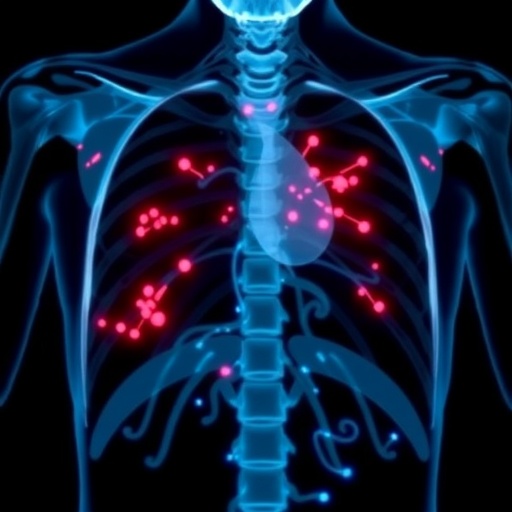In a groundbreaking advancement at the intersection of medical imaging and artificial intelligence, researchers have unveiled an interpretable machine learning model that leverages computed tomography (CT) radiomic features alongside clinical data to predict the onset of urosepsis in patients undergoing percutaneous nephrolithotomy (PCNL). Urosepsis, a severe and potentially fatal systemic infection resulting from urinary tract complications, demands rapid and accurate diagnosis. This innovative model provides clinicians a powerful tool to foresee this life-threatening condition earlier than ever before.
The study brought together a cohort of 401 patients diagnosed with kidney stones from two separate medical centers, all of whom underwent PCNL—a minimally invasive surgical procedure to remove renal calculi. Urosepsis following PCNL, although relatively rare at a rate of about 7.5% in this population, poses significant health risks, necessitating precise predictive analytics to guide timely intervention. Traditional predictive methods have often fallen short, highlighting the need for advanced computational models that integrate multifaceted patient data.
To address this challenge, the research team employed a sophisticated approach to data balancing in their training set using the Synthetic Minority Over-sampling Technique for Regression with Gaussian Noise (SMOGN). This method enhanced the representation of minority cases in the dataset, facilitating a model that better generalizes to real-world clinical scenarios where urosepsis cases are infrequent. The importance of such data engineering cannot be overstated in developing robust predictive algorithms in healthcare.
Radiomic features, which quantify tumor heterogeneity and other imaging phenotypes invisible to the naked eye, were meticulously extracted from the patients’ CT scans. Through the application of the Absolute Shrinkage and Selection Operator (LASSO), a statistical technique for feature selection and regularization, thirteen critical radiomic features were identified and combined into a radiomics score. This composite score distilled complex imaging data into actionable clinical indicators predictive of urosepsis risk.
Recognizing the multifactorial nature of urosepsis, the model incorporated six vital clinical variables alongside the radiomics score. These included urine nitrite positivity, stone volume, mean intrarenal pressure during surgery, urine white blood cell count, and operation duration. Each of these parameters carries significant physiological relevance, collectively painting a comprehensive picture of patient risk factors beyond imaging data alone.
The model’s predictive capability was rigorously evaluated through seven different machine learning algorithms, ultimately showcasing the superiority of CatBoost, a gradient boosting decision tree algorithm renowned for handling heterogeneous data effectively. Performance metrics underscored CatBoost’s excellence, with impressive area under the receiver operating characteristic curve (AUC-ROC) values of 0.88 in training, 0.94 in internal tests, and 0.89 in external validation sets—signaling a high degree of accuracy and reliability.
Further strengthening the clinical utility of the model, the team deployed the Shapley Additive exPlanations (SHAP) framework, a cutting-edge technique that provides transparent explanations of how each feature influences the model’s predictions. This interpretability is critical for trust and adoption in medical practice, allowing clinicians to understand and verify the factors driving the risk assessments, with the radiomics score and urine nitrite positivity emerging as the most influential contributors.
The implications of this research extend well beyond its technical achievements. By offering a web-deployable predictive tool accessible at https://predictive-model-for-urosepsis.streamlit.app/, healthcare providers worldwide can harness advanced AI-driven insights to identify patients at heightened urosepsis risk swiftly. Early detection enables preemptive measures that could markedly reduce morbidity and mortality associated with post-PCNL infections.
The fusion of CT radiomics and clinical parameters in this interpretable model exemplifies the transformative potential of AI in personalized medicine. It bridges the gap between complex data analytics and frontline clinical decision-making, ensuring that nuanced signals extracted from imaging and laboratory data translate into meaningful patient outcomes. Such integrations herald a new era where diagnostics are not only intelligent but also explainable and actionable.
Moreover, the methodological rigor—encompassing multi-center data collection, sophisticated oversampling, and cross-validation procedures—sets a high standard for future studies aiming to apply machine learning in urology and infectious disease prediction. The transparent approach adopted by the researchers signals a move away from opaque “black box” models, emphasizing the critical balance of accuracy, interpretability, and clinical relevance.
Given the rising incidence of kidney stone disease globally and the attendant risks of urosepsis following surgical intervention, the deployment of such refined predictive tools could reshape postoperative management strategies. By integrating patient-specific imaging biomarkers with key clinical factors, tailored surveillance and intervention protocols may be crafted, optimizing resource allocation and improving patient outcomes.
As machine learning continues to permeate healthcare, studies like this illuminate the roadmap for integrating AI into routine clinical workflows. The emphasis on interpretability, demonstrated by the use of SHAP values, assures clinicians that AI models can complement rather than complicate their expertise. This model exemplifies the symbiotic relationship between human insight and computational power, a partnership essential for tackling complex medical challenges.
In summary, the study presents a significant advance in predictive analytics for urosepsis post-PCNL, combining cutting-edge radiomics with clinical data through an interpretable machine learning framework. This innovation promises to enhance early diagnosis, enable proactive interventions, and ultimately save lives. The available web-based tool offers an immediate avenue for clinical application, marking a remarkable step forward in precision urological care.
Subject of Research:
Prediction of urosepsis after percutaneous nephrolithotomy using an interpretable machine learning model combining CT radiomics and clinical features.
Article Title:
An interpretable machine learning model integrating computed tomography radiomics and clinical features for predicting the urosepsis after percutaneous nephrolithotomy.
Article References:
Zeng, S., Cao, Z., Xu, H. et al. An interpretable machine learning model integrating computed tomography radiomics and clinical features for predicting the urosepsis after percutaneous nephrolithotomy. BioMed Eng OnLine 24, 122 (2025). https://doi.org/10.1186/s12938-025-01460-y
Image Credits: AI Generated




